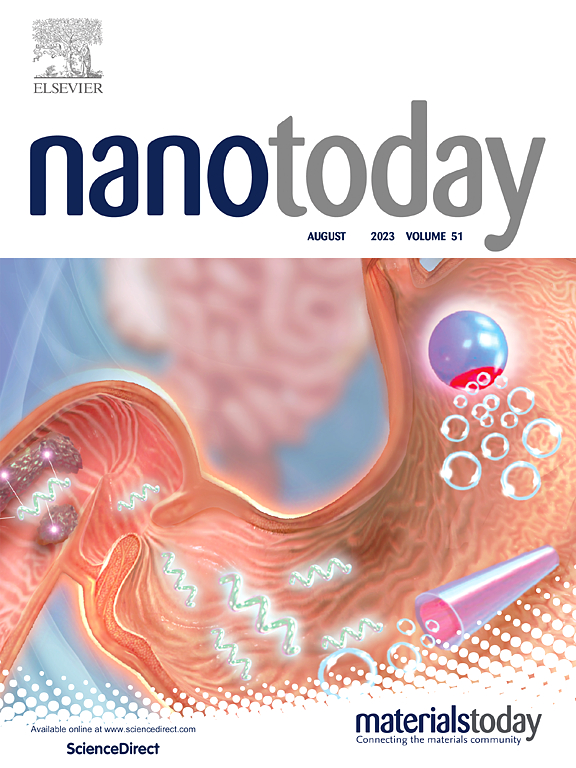携带抗菌肽的 DNA 纳米管可提高抗感染治疗效果
IF 13.2
1区 材料科学
Q1 CHEMISTRY, MULTIDISCIPLINARY
引用次数: 0
摘要
抗菌肽(AMPs)是治疗感染以克服日益严重的抗生素耐药性问题的良好替代品。DNA 纳米结构已被用作 AMPs 的传输载体,以提高其性能,但其作用机制仍不十分明确。在这项工作中,DNA 纳米管(DNT)因其高结合亲和力和负载能力而被选为 AMPs 的首选载体,并通过分子模拟和随后的负载实验筛选出一种名为 RP557 的工程化广谱 AMP 作为载体。然后通过静电作用将 RP557 分子负载到 DNT 上,构建 RP557@DNT 纳米复合物,用于提高抗感染治疗效果。与游离的 RP557 相比,负载的 RP557 在体外对成纤维细胞和上皮细胞的细胞毒性更低,与红细胞的相容性更高,而且 RP557@DNT 在动物实验中表现出良好的生物降解性和生物安全性。此外,与游离的 RP557 相比,RP557@DNT 在体外和体内都具有更好的杀菌活性,因为负载的 RP557 对血清蛋白酶降解具有更强的抵抗力,并可控地释放到细菌细胞膜上。RP557@DNT 的高治疗效果主要取决于炎症的加速消退(包括减少促炎因子的产生、先天性免疫细胞的招募和适应性免疫)和组织修复(包括上调多种表皮和真皮修复途径)。总之,与游离 RP557 相比,RP557@DNT 在抗酶溶解、抗菌活性和生物安全性方面都有显著提高,因此是治疗难治性感染的高效抗生素替代策略。本文章由计算机程序翻译,如有差异,请以英文原文为准。
DNA nanotube-carrying antimicrobial peptide confers improved anti-infective therapy
Antimicrobial peptides (AMPs) represent a good alternative for treating infections to overcome increasing antibiotic resistance problems. DNA nanostructures have been utilized as the delivery carrier of AMPs to enhance their performance, but mechanisms of action remain largely unclear. In this work, DNA nanotube (DNT) was chosen as a preferred carrier of AMPs owing to its high binding affinity and loading capacity, and an engineered broad-spectrum AMP named RP557 was screened as the cargo though molecular simulation and subsequent loading experiments. RP557 molecules were then loaded onto DNT through electrostatic interaction to construct RP557@DNT nanocomplex for improved anti-infective therapy. Loaded RP557 possessed the lower cytotoxicity to fibroblasts and epithelial cells and the higher compatibility to red blood cells relative to free RP557 in vitro, and RP557@DNT displayed the highly favored biodegradability and biosafety at the animal level. In addition, compared to free RP557, RP557@DNT endowed better bactericidal activity in vitro and in vivo because loaded RP557 exhibited higher resistance to serum protease degradation and controlled release onto bacterial cell membrane. The high therapeutic effect of RP557@DNT primarily depended on the acceleration of inflammation resolution (involving the reduction in proinflammatory factor production, innate immune cell recruitment, and adaptive immunity) and tissue repair (involving the up-regulation of multiple epidermal and dermal repair pathways). In summary, RP557@DNT showed significantly enhanced anti-enzymolysis, antibacterial activity, and biosafety relative to free RP557, and thus it represented a high-efficiency antibiotics-alternative strategy for treating refractory infections.
求助全文
通过发布文献求助,成功后即可免费获取论文全文。
去求助
来源期刊

Nano Today
工程技术-材料科学:综合
CiteScore
21.50
自引率
3.40%
发文量
305
审稿时长
40 days
期刊介绍:
Nano Today is a journal dedicated to publishing influential and innovative work in the field of nanoscience and technology. It covers a wide range of subject areas including biomaterials, materials chemistry, materials science, chemistry, bioengineering, biochemistry, genetics and molecular biology, engineering, and nanotechnology. The journal considers articles that inform readers about the latest research, breakthroughs, and topical issues in these fields. It provides comprehensive coverage through a mixture of peer-reviewed articles, research news, and information on key developments. Nano Today is abstracted and indexed in Science Citation Index, Ei Compendex, Embase, Scopus, and INSPEC.
 求助内容:
求助内容: 应助结果提醒方式:
应助结果提醒方式:


